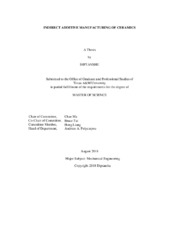| dc.description.abstract | Additive manufacturing of ceramics has gained a lot of impetus recently due to its ability to do away with the costs of machining ceramics. In this study, the feasibility of two popular methods: indirect selective laser sintering (SLS) and vat photopolymerization was studied. The focus of this research is on feedstock material preparation of these two processes.
Firstly, temperature induced phase separation (TIPS) was used to prepare three different powders containing varied amounts of polyamide and alumina composite microspheres. Flowability versus sinterability of the feedstock composite powder was studied. The results showed that as the fraction of polyamide in the composite powder increased, the flowability of the powder increased, however the sinterability decreased. Inferentially, a fine balance of flowability versus sinterability must be maintained in order to produce dense crack free alumina 3D parts by indirect SLS.
Secondly, vat photopolymerization was chosen to produce 3D alumina parts using the commercial vat photopolymerization printer (Nobel Superfine, XYZprinting). Four green bodies using a photopolymerizable ceramic suspension were created. All were subjected to the same parameters of thermal processing. A quantitative study of the amount of open and closed pores and their dependence on the size of the sintered parts was done. The lowest porosity was observed in the smallest cubes (5 mm).
Finally, green bodies using the vat photopolymerization technique were created using three monomodal and three bimodal ceramic suspensions consisting of varying volumes of alumina particles in an in-house photopolymerizable resin. A quantitative study of the
apparent solid and bulk densities of the specimens was done. The sample containing 0.3 μm particles achieved the highest density among the monomodal suspensions. The sample containing 0.3 μm & 0.8 μm particles achieved the highest density among the bimodal suspensions. This work demonstrated that adding a small amount of a finer ceramic powder as dopant to a larger sized ceramic powder significantly improved the sinterability of the green part.
The promising nature of vat photopolymerization of ceramics presents great opportunities for the production of high density ceramics using a bottom-up 3D printer by optimizing the fractions of different components of a photopolymerizable ceramic suspension. | en |


